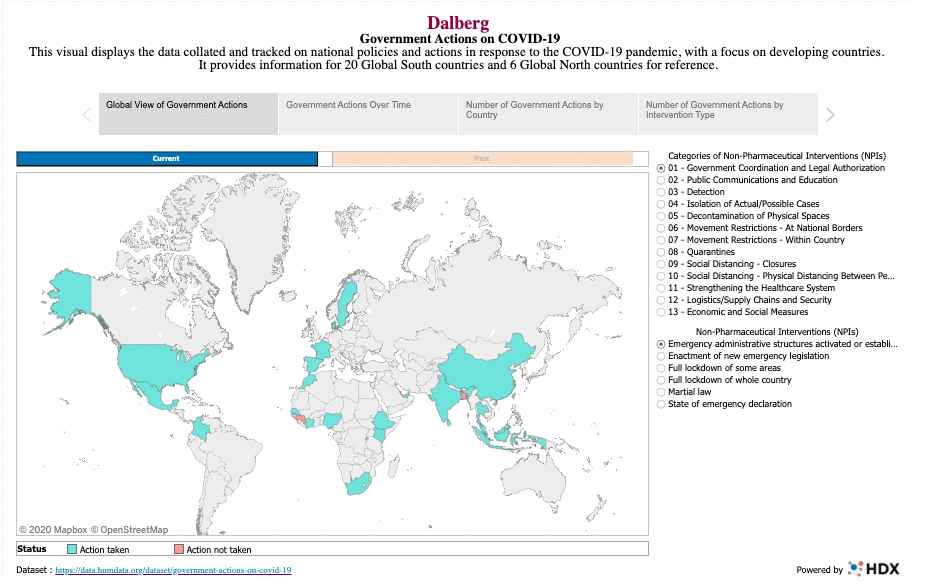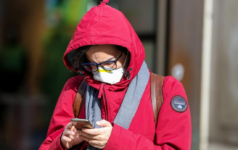Dalberg uses cookies and related technologies to improve the way the site functions. A cookie is a text file that is stored on your device. We use these text files for functionality such as to analyze our traffic or to personalize content. You can easily control how we use cookies on your device by adjusting the settings below, and you may also change those settings at any time by visiting our privacy policy page.
A new Dalberg database spotlights the policies and measures governments are taking to control the spread of the pandemic and manage its impacts.
Governments around the world have introduced drastic measures to control the spread of COVID-19 and to manage its impacts. Information on what actions have been taken in different countries is valuable both for decision-makers and for researchers aiming to compare actions and assess their effectiveness. However, information on actions in developing countries is patchy, and it is often hard to compare actions across countries, as the details of measures taken can vary quite significantly from place to place.
Dalberg has created a new resource – “The Database of Government Actions on COVID-19 in Developing Countries”, a database that collates and tracks national policies and actions in response to the pandemic, with a focus on developing countries. The database can be found on the Humanitarian Data Exchange, an open platform for sharing data across crises and organizations that is managed by OCHA’s Centre for Humanitarian Data.
Information for 20 Global South countries is included in Dalberg’s database – plus 6 Global North countries for reference – that Dalberg staff are either based in or know well. The database content is drawn from publicly available information combined, crucially, with on-the-ground knowledge of Dalberg staff.
The database contains a comprehensive set of 100 non-pharmaceutical interventions, organized in a framework intended to make it easy to observe common variations between countries in the scope and extent of major interventions. Interventions we are tracking include:
- Health-related: strengthening of healthcare systems, detection and isolation of actual/possible cases, quarantines
- Policy-related: government coordination and legal authorization, public communications and education, movement restrictions
- Distancing and hygiene: social distancing measures, movement restrictions, decontamination of physical spaces
- Economic measures: economic and social measures, logistics/supply chains and security.

We hope the database will be a useful resource for several groups of users: (i) governments and policymakers looking for a quick guide to actions taken by different countries—including a range of low- and middle-income countries, (ii) policy analysts and researchers studying the data to identify patterns of actions taken and compare the effectiveness of different interventions in curbing the pandemic, and (iii) media and others seeking to quickly access facts about the actions taken by governments in the countries covered in the database.
The database includes compiled data in two forms: (i) the summary tab, which provides a visualization of all the interventions, and indicates whether or not countries have enacted them, and (ii) the integrated list of actions tab, which compiles data in a form that is more conducive to data analyses.
Emerging trends: the timing of interventions in relation to caseloads, death tolls, and WHO’s pandemic classification
Governments took most of their actions to stem the COVID-19 outbreak during the three weeks around and after the WHO’s classification of the outbreak as a pandemic on Wednesday 11 March.
Close to two-thirds of actions (60%) taken by the 25 governments occurred in the three weeks between 8 and 27 March. These three weeks stand out among others—the remaining actions are fairly spread out over the weeks before and after this period.
The classification of COVID-19 as a pandemic may have spurred some countries to take action, while others may have implemented interventions to align with actions taken by other countries. It is possible that, for some countries, these two considerations—more so than the course of the pandemic within each specific country—were paramount in prompting new interventions.
As evidence of this, it is worth noting that actions taken by countries in the database are less strongly correlated to the timing of milestones in the progress of COVID-19 in each country. Less than half of interventions were announced in the three busiest weeks relative to the dates of the country’s 10th case, 100th case and first death (46%, 49% and 46% respectively).
Figure 1: Week that measures were taken (% of total)

Figure 2: Week that measures were taken, relative to the country’s 10th case (% of total)

Figure 3: Week that measures were taken, relative to the country’s 100th case (% of total)

Figure 4: Week that measures were taken, relative to the country’s 1st death (% of total)

While it seems that some countries that took actions early have had better outcomes, e.g., Taiwan and New Zealand, the full benefits or costs of taking actions earlier or later will only become apparent after the pandemic is over. Additionally, while the caseload and number of deaths can serve as indicators of the course of the pandemic, a broader set of indicators will also need to be studied in order to make these kinds of determinations.
In the coming months, as nations modify, lift, and potentially re-impose restrictions, the timing of governmental actions will likely remain critical. We hope that The Database of Government Actions on COVID-19 in Developing Countries—and other databases like it—can provide policymakers in the midst of this crisis with a reliable source of information on the range and timing of measures taken by their counterparts around the world. We hope, too, that the database will inform future research into how the timing of these interventions ultimately affected their outcomes—and that these analyses can help improve the effectiveness of decision-making in future public health crises.
















